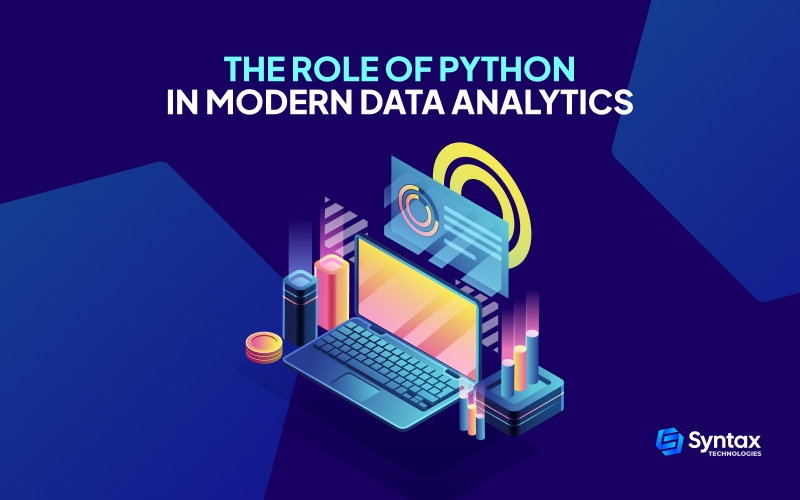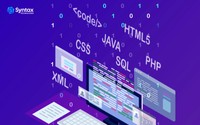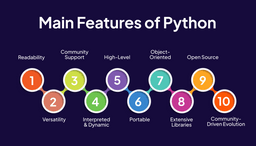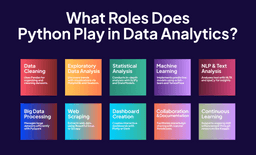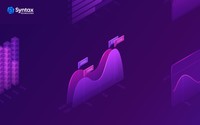Ever wonder how data magically transforms into meaningful insights that drive decisions?
Let’s say you’re a coffee enthusiast, and you want to explore the perfect brewing time for your morning cup.
Well, Python can help you analyze data on brewing parameters like time, temperature, and grind size, guiding you to that impeccable brew.
In this journey through the digital landscape, Python emerges as your trusty sidekick, making complex data as easy to understand as your favorite cup of joe.
Before starting your data analytics course, it’s best to get familiar with the features and uses of this popular programming language.
So, grab your detective hats because, with Python, we’re about to embark on a thrilling journey of decoding and discovery in the vast universe of data analytics.
What Programming Languages are the Most Used in Data Analytics?
In the dynamic field of data analytics, several programming languages have gained prominence due to their versatility, ease of use, and a robust ecosystem of libraries.
Here are some of the most used programming languages in data analytics:
Python: The Powerhouse of Data Analytics
- Why: Python is the go-to language for data analytics due to its readability, versatility, and extensive library support.
- Libraries: Pandas, NumPy, Matplotlib, Seaborn, scikit-learn, TensorFlow, PyTorch.
R: Specialized for Statistics and Data Visualization
- Why: R is renowned for statistical analysis and data visualization, making it a favorite among statisticians and data scientists.
- Libraries: ggplot2, dplyr, tidyr, caret.
SQL: The Language of Databases
- Why: SQL is indispensable for working with relational databases & extracting and manipulating data.
- Use Cases: Querying databases, data extraction, transformation, and loading (ETL).
SAS: Widely Used in Business Analytics
- Why: SAS (Statistical Analysis System) is a software suite extensively used in business analytics and data management.
- Use Cases: Statistical analysis, data management, predictive modeling.
Java: Scalability and Big Data
- Why: Java is known for its scalability and is often used in big data processing frameworks.
- Use Cases: Hadoop, Apache Spark.
Scala: A Concise and Scalable Language
- Why: Scala is preferred for its concise syntax and scalability, particularly in big data processing.
- Use Cases: Apache Spark.
MATLAB: Numeric Computing and Simulation
- Why: MATLAB is widely used in academia and industry for numerical computing, simulation, and algorithm development.
- Use Cases: Signal processing, image analysis, machine learning.
Excel: Ubiquitous Spreadsheet Tool
- Why: While not a traditional programming language, Excel is extensively used for quick data analysis and visualization.
- Use Cases: Simple data analysis, visualization, and reporting.
The choice of programming language often depends on the specific requirements of the data analytics task, the preferences of the analyst or data scientist, and the existing tools and infrastructure in use.
Python, with its rich ecosystem, is a popular choice for its flexibility and broad applicability across various data analytics tasks. However, specialized tasks may benefit from the strengths of other languages like R, SQL, or MATLAB.
Now, let’s get into Python, the programming language you came for!
Overview on Python
So, before we dive headfirst into the wonders of Python in the realm of data analytics, let’s take a quick peek behind the scenes.
It’s the late 1980s, and a Dutch programmer named Guido van Rossum is cooking up something special. Enter Python, a programming language not named after the snake but rather a nod to Monty Python’s Flying Circus, showcasing the quirky and fun spirit embedded in its coding DNA.
Python officially made its debut in 1991, and since then, it’s been on a journey, evolving into a versatile and powerful tool embraced by developers, data scientists, and coffee enthusiasts alike.
With its readability, simplicity, and vast community support, Python has become the unsung hero we’re about to explore in the fascinating world of modern data analytics.
What are the Main Features of Python?
Alright, let’s break down the main features of Python, the superhero of the programming world, in the same friendly and approachable style:
Readability and Simplicity:
- Python code reads like plain English, making it beginner-friendly and easy on the eyes.
- The emphasis is on simplicity, reducing the cost of program maintenance and development.
Versatility:
- Python can handle a wide range of applications, from web development to data analysis, artificial intelligence, and more.
- Its adaptability makes it a go-to language for developers in various domains.
Community Support:
- The Python community is like a global village of friendly developers always ready to help.
- A plethora of libraries and frameworks are available, thanks to the collaborative spirit of the Python community.
Interpretation and Dynamism:
- Python is an interpreted language, allowing for quick development and testing.
- Its dynamic typing system means you don’t have to declare variable types, enhancing flexibility explicitly.
High-Level Language:
- Python’s high-level nature abstracts complex details, making it more focused on problem-solving than managing system resources.
Portability:
- Python code can run on various platforms without modification, promoting cross-platform compatibility.
Object-Oriented:
- Python supports object-oriented programming, facilitating the creation and reuse of code through classes and objects.
Extensive Libraries:
- Python boasts a rich ecosystem of libraries and frameworks, like NumPy for numerical operations and Django for web development, saving developers time and effort.
Open Source:
- Python is open source, meaning its source code is freely available, fostering collaboration and continuous improvement.
Community-driven Evolution:
- Python’s development is influenced by community input, ensuring it stays relevant and meets the evolving needs of its users.
In a nutshell, Python’s features make it a powerful, accessible, and adaptable language, making coding feel like a superhero adventure rather than a daunting task.
What Roles Does Python Play in Data Analytics?
Let’s explore the roles that Python plays in the enchanting world of data analytics, all while keeping it friendly, inspirational, and personal:
Data Wrangling and Cleaning:
Python is your data janitor, helping you clean and organize messy datasets. Imagine you have a dataset with missing values and inconsistencies. Python, armed with libraries like Pandas, swoops in to tidy things up, ensuring your data is ready for analysis.
Exploratory Data Analysis (EDA):
Python becomes your detective, uncovering hidden patterns and trends in the data. With tools like Matplotlib and Seaborn, Python creates vibrant visualizations, transforming raw numbers into compelling stories that even those not fluent in data speak can understand.
Statistical Analysis:
Python dons the mathematician’s hat, performing statistical analyses to extract meaningful insights. Using libraries such as SciPy and StatsModels, Python can conduct hypothesis testing or regression analysis, helping you understand the significance of your findings.
Machine Learning:
Python morphs into your AI assistant, implementing machine learning algorithms for predictive modeling. Employing scikit-learn or TensorFlow, Python can predict future trends based on historical data, like forecasting sales or predicting customer behavior.
Text Analysis and Natural Language Processing (NLP):
Python transforms into a linguistic genius, deciphering the language hidden in text data. Using the Natural Language Toolkit (NLTK) or spaCy, Python can analyze sentiment in customer reviews, helping businesses understand public perception.
Big Data Processing:
Python evolves into your big data conductor, orchestrating the analysis of massive datasets. With tools like PySpark, Python can handle large-scale data processing, making it possible to analyze vast amounts of information efficiently.
Web Scraping:
Python turns into your digital explorer, gathering data from websites for analysis. Using libraries such as Beautiful Soup or Scrapy, Python can scrape data from websites, whether for competitor analysis or tracking online trends.
Dashboard Creation:
Python transforms into your storyteller, crafting interactive dashboards to share insights. Utilizing tools like Plotly or Dash, Python can turn your analytical findings into engaging dashboards, allowing stakeholders to interact with the data firsthand.
Collaboration and Documentation:
Python is your diligent scribe, documenting code and analyses for future reference. Leveraging Jupyter Notebooks, Python ensures your data analysis journey is well-documented, fostering collaboration and knowledge sharing.
Continuous Learning and Improvement:
Python becomes your mentor, offering a vast ecosystem of resources for ongoing learning. Platforms like Kaggle and online data science courses make Python an integral part of your learning journey, empowering you to enhance your data analytics skills continuously.
In this enchanting adventure of data analytics, Python wears many hats, each contributing to the narrative of transforming raw data into actionable insights.
Embarking on the Python Journey for Data Analytics
Embarking on the thrilling Python journey for data analytics is like setting out on a grand adventure with a trusty companion.
Picture Python as your linguistic sidekick, designed to make the exploration of data’s nuances a breeze, unraveling mysteries hidden within the digits and decimals.
Setting the Stage: Installation of Python and Jupyter Notebooks
Let’s kick off this Python escapade by setting up camp. Install Python and its trusty sidekick, Jupyter Notebooks ? your base camp for the exhilarating journey into the world of data exploration.
Learning the Basics of Python: A New Language Unveiled
Get ready to make a new friend! Familiarize yourself with the basics of Python, treating it like you’re getting to know a brand-new language. Platforms like Codecademy and SoloLearn offer beginner-friendly courses, building a solid foundation for your Python pal.
Meeting Your Sidekicks: Pandas, NumPy, Matplotlib, and Seaborn
Now, let’s dive into the exciting realm of data wrangling with your indispensable sidekicks ? Pandas and NumPy. These dynamic duos transform complex datasets into manageable insights. Unleash the artistic side of Python with Matplotlib and Seaborn, turning raw numbers into visually compelling narratives through plots and visualizations.
Embarking on Mini-Adventures: Real-Life Projects
Ready for some real-life action? Apply your newfound Python skills to projects like analyzing personal expenses or tracking fitness data. These mini-adventures reinforce your learning and make the journey more rewarding and applicable to your everyday life.
Leveling Up: Advanced Topics, Machine Learning Magic
Gear up for the next level of your Python expedition by delving into the magic of machine learning using scikit-learn. Conquer beginner-friendly machine learning projects and gradually explore more complex challenges to enhance your analytical superpowers.
Communication and Documentation: Jupyter Notebooks as Your Personal Diary
Your data adventures need a diary! Utilize Jupyter Notebooks for documentation, turning them into a personalized record of your data escapades. These notebooks help you record your analyses and make your findings accessible and organized.
Joining the Python Community: Finding Your Tribe
No adventure is complete without fellow explorers! Engage in forums like Stack Overflow and join social media groups to connect with kindred spirits. The Python community is your support system ? a place to share experiences, seek advice, and continuously learn from others.
Continuous Learning: Online Courses and Challenges
Keep the momentum going by enrolling in online courses and challenges on platforms like Coursera, edX, or Kaggle. Stay current with industry trends and continuously sharpen your Python skills.
Reflecting on the Journey: Continuous Improvement
Pause and celebrate your victories! Regularly reflect on your journey, acknowledging challenges as stepping stones to mastery. Remember, continuous improvement is the secret sauce to mastering the art of data analytics with Python.
Gearing Up for the Grand Quest: Career Transition
Feeling confident? It’s time to consider transitioning into a data analyst role, applying your Python skills to real-world problems, and making a meaningful impact in the field. Update your resume, seek entry-level positions or internships, and embark on the grand quest that awaits.
Embarking on the Python Best Practices Adventure
Mastering Python is like unlocking the secrets to writing code that’s not just efficient but downright enchanting.
These practices are your guide to crafting code that’s readable and efficient!
Follow PEP 8: The Style Guide
PEP 8, the Pythonic sage of style guides, beckons you into the world of clean and readable code. Adhering to its wisdom ensures your code speaks a consistent language across projects.
Example: Let your code breathe with 4 spaces per indentation level, keep lines under 79 characters, and bid farewell to any sneaky extra whitespace.
Use Meaningful Variable and Function Names
Let your variables and functions tell a story. Choosing names that narrate their purpose makes your code not just functional but also a joy to read.
Example: Say goodbye to vague names like temp; say hello to descriptive elegance with temperature. Trade in the mysterious f() for the storytelling beauty of calculate_average().
Document Your Code
Become a storyteller with your code. Document your modules, classes, and functions using docstrings ? the narrative threads that guide fellow developers through your code’s epic journey.
Example: Open the gates of understanding with triple-quoted docstrings, revealing the purpose, parameters, and return values of your functions.
Modularize Code with Functions and Classes
Break down the complexity. Turn your code into a symphony of functions and classes, each playing a distinct note in the melody of reusability and clarity.
Example: If a piece of code has a mission, bestow upon it the title of a function with a clear purpose.
Handle Exceptions Gracefully
Be the maestro of error-handling. Use the magic of try, except, and finally blocks to orchestrate a symphony that prevents crashes and gracefully recovers from errors.
Example: Wrap potentially troublesome code in a try block and dance through errors with grace in the except block.
Virtual Environments for Dependency Management
Create a sanctuary for dependencies. Embrace the power of virtual environments (venv or virtualenv) to ensure each project has its own set of dependencies, avoiding conflicts.
Example: Weave a protective cocoon for your project by creating a virtual environment with python -m venv env.
Version Control with Git
Become a code historian. Employ Git as your time-traveling companion, tracking changes and providing a safety net for your coding experiments.
Example: Start your version control journey by initializing a Git repository with git init and commit changes regularly.
Unit Testing
Become a code guardian. Write unit tests that stand as vigilant protectors, ensuring correctness, catching bugs early, and preserving the harmony of existing functionality.
Example: Let your unittest or pytest frameworks be the vigilant knights guarding the gates of your functions and classes.
Use List Comprehensions and Generator Expressions
Embrace the elegance of lists. Utilize list comprehensions and generator expressions to craft concise and efficient code, turning mundane tasks into poetry.
Example: Instead of the old, dance with the new ? use a list comprehension like [x**2 for x in range(10)].
Be Mindful of Memory Usage
Become a memory whisperer. Avoid unnecessary consumption; be aware of the spells that may lead to memory leaks.
Example: Let generators be your memory-friendly spells for handling large datasets without summoning the entire memory army.
Keep Dependencies Updated
Stay in tune with the latest beats. Regularly update your project dependencies, embracing bug fixes, security updates, and the sweet melodies of new features.
Example: Command your dependencies to ascend to greatness with pip install –upgrade package-name.
Code Reviews and Collaboration
Open the gates of collaboration. Engage in code reviews, where diverse perspectives merge to elevate the quality of your code to new heights.
Example: Unleash the collaborative magic using platforms like GitHub for shared development and collective code reviews.
Starting Your Data Analytics Odyssey with Syntax Technologies
As we conclude this enchanting journey into Python, remember that your exploration has just begun.
With Python as your linguistic companion and these best practices as your guiding light, the world of data analytics awaits your unique perspective.
At Syntax Technologies, we understand the excitement and challenges of starting your data analytics journey.
Our comprehensive course is designed not just to teach you Python but to immerse you in the practical magic of data manipulation, visualization, and analysis.
We believe in a hands-on approach, turning every lesson into a mini-adventure and every challenge into a victory that propels you forward.
